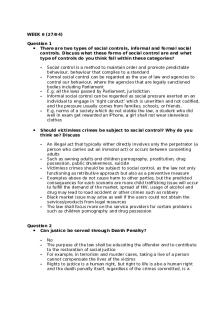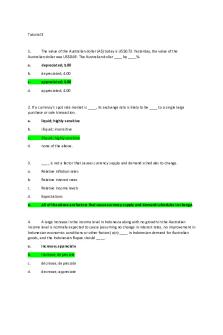Tutorial 3 PDF

| Title | Tutorial 3 |
|---|---|
| Author | Hamood Habibi |
| Course | Advanced Topics in Mathematics II |
| Institution | Macquarie University |
| Pages | 6 |
| File Size | 438.8 KB |
| File Type | |
| Total Views | 161 |
Summary
Tutorial for week 3...
Description
UOWD STAT 291 Dr. Assane Lo
Tutorial 3 Problem 1 Find the number of ways of forming four-digit codes in which no digit is repeated.
Problem 2 Forty-three race cars started the 2010 Daytona 500. How many ways can the cars finish first, second, and third?
Problem 3 A state’s department of transportation plans to develop a new section of interstate highway and receives 16 bids for the project. The state plans to hire four of the bidding companies. How many different combinations of four companies can be selected from the 16 bidding companies?
Problem 4 A student advisory board consists of 17 members. Three members serve as the board’s chair, secretary, and webmaster. Each member is equally likely to serve in any of the positions. What is the probability of selecting at random the three members who currently hold the three positions? (Stat (Stat
Problem 5 A food manufacturer is analysing a sample of 400 corn kernels for the presence of a toxin. In this sample, three kernels have dangerously high levels of the toxin. If four kernels are randomly selected from the sample, what is the probability that exactly one kernel contains a dangerously high level of the toxin?
(Stat
Problem 6 Computer chips often contain surface imperfections. For a certain type of computer chip, 9% contain no imperfections, 22% contain 1 imperfection, 26% contain 2 imperfections, 20% contain 3 imperfections, 12% contain 4 imperfections, and the remaining 11% contain 5 imperfections. Let X represent the number of imperfections in a randomly chosen chip. What are the possible values for X? Is X discrete or continuous? Find P(X = x) for each possible value x.
Solution • • • • •
The possible values for X are the integers 0, 1, 2, 3, 4, and 5. The random variable X is discrete, because it takes on only integer values. Nine percent of the outcomes in the sample space are assigned the value 0. Therefore P(X = 0) = 0.09. Similarly P(X = 1) = 0.22, P(X = 2) = 0.26, P(X = 3) = 0.20, P(X = 4) = 0.12, and P(X = 5) = 0.11. The distribution table is:
Problem 7 The number of flaws in a 1-inch length of copper wire manufactured by a certain process varies from wire to wire. Overall, 48% of the wires produced have no flaws, 39% have one flaw, 12% have two flaws, and 1% have three flaws. Let X be the number of flaws in a randomly selected piece of wire. Then: P(X = 0) = 0.48,
P(X = 1) = 0.39,
P(X = 2) = 0.12,
P(X = 3) = 0.01
Let F(x) denote the cumulative distribution function of the random variable X that represents the number of flaws in a randomly chosen wire. Find F(2). Find F(1.5).
Solution • • •
• • •
Since F (2) = P(X 2), we need to find P(X 2). We do this by summing the probabilities for the values of X that are less than or equal to 2, namely, 0, 1, and 2. Thus F (2) = P(X ≤ 2) = P(X = 0) + P(X = 1) + P(X = 2) = 0.48 + 0.39 + 0.12 = 0.99 Now F (1.5) = P(X ≤ 1.5). Therefore, to compute F(1.5) we must sum the probabilities for the values of X that are less than or equal to 1.5, which are 0 and 1. Thus F (1.5) = P(X ≤ 1.5) = P(X = 0) + P(X = 1) = 0.48 + 0.39 = 0.87
Problem 8 A supervisor in a manufacturing plant has three men and three women working for him. He wants to choose two workers for a special job. Not wishing to show any biases in his selection, he decides to select the two workers at random. Let X denote the number of women in his selection. Find the probability distribution for X.
Solution •
The supervisor can select two workers from 6 in
different ways. •
The random variable X can take the values 0, 1, and 2.
•
Distribution:
Problem 9 Decide whether the distribution is a probability distribution. Explain your reasoning.
Solution 1) Each probability is between 0 and 1, but the sum of all the probabilities is 1.07, which is greater than 1. So, it is not a probability distribution. 2) The sum of all the probabilities is equal to 1, but and are not between 0 and 1. So, it is not a probability distribution. Probabilities can never be negative or greater than 1....
Similar Free PDFs

Tutorial 3
- 3 Pages

Tutorial 3
- 4 Pages

Tutorial 3
- 4 Pages

Tutorial 3
- 12 Pages

3 - tutorial
- 6 Pages

Tutorial 3
- 6 Pages

Tutorial 3
- 4 Pages

Tutorial 3 - Lecture notes 3
- 5 Pages

Tutorial 3 Answers
- 4 Pages

Tutorial 3 Solutions - EC202
- 4 Pages

Tutorial 3 Solution - investment
- 3 Pages

Tutorial 3 - ccc
- 1 Pages

Tutorial work - 1 - 3
- 31 Pages

Tutorial 3 - Answers
- 6 Pages

OD tutorial 3
- 5 Pages

DEL tutorial 3
- 2 Pages
Popular Institutions
- Tinajero National High School - Annex
- Politeknik Caltex Riau
- Yokohama City University
- SGT University
- University of Al-Qadisiyah
- Divine Word College of Vigan
- Techniek College Rotterdam
- Universidade de Santiago
- Universiti Teknologi MARA Cawangan Johor Kampus Pasir Gudang
- Poltekkes Kemenkes Yogyakarta
- Baguio City National High School
- Colegio san marcos
- preparatoria uno
- Centro de Bachillerato Tecnológico Industrial y de Servicios No. 107
- Dalian Maritime University
- Quang Trung Secondary School
- Colegio Tecnológico en Informática
- Corporación Regional de Educación Superior
- Grupo CEDVA
- Dar Al Uloom University
- Centro de Estudios Preuniversitarios de la Universidad Nacional de Ingeniería
- 上智大学
- Aakash International School, Nuna Majara
- San Felipe Neri Catholic School
- Kang Chiao International School - New Taipei City
- Misamis Occidental National High School
- Institución Educativa Escuela Normal Juan Ladrilleros
- Kolehiyo ng Pantukan
- Batanes State College
- Instituto Continental
- Sekolah Menengah Kejuruan Kesehatan Kaltara (Tarakan)
- Colegio de La Inmaculada Concepcion - Cebu